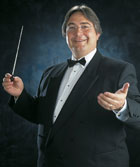Expert workshop - Section 4 - Anglian Dances
17-Feb-2006Dr. Robert Childs takes a closer look at Alan Fernie's enjoyable Anglian Dances and finds a piece that will need a lot of care and attention to make into a winning performance.
 I:
I:
To achieve the majestic feel of this opening movement make sure you are not too fast with the tempo and keep the quavers broad. If you play too fast and short it will sound more like a march.
Look for the detail, accents in bar 3 (trombones) but remember the dynamic is only forte. Make a real difference when you do have fortissimo in bar 8.
At B change the style to cantabile and legato, maybe add some expression but don't get slower. Letter C has a slight lift in dynamic and again there is some interesting detail in bar 17 and 18 (accents in cnts and tenutos in hns). Make sure the triangle is heard. Bar 21 feel the crescendo and sort out the release in the trombones. One beat before D you need clear semi-quavers from the lower end. Make sure the 4th bar of E is fortissimo.
Don't slow down too soon; maybe go into quaver beats on the half bar, two bars from the end.
II:
This movement relies on the lilting feel of dotted minim = 63-69, too fast and it will sound military and loose its gentleness, too slow and it will become a dirge. Maybe start off beating 3 in a bar, and slip into 1 at letter A.
Always look for the new sounds that appear in the percussion and don't be too violent with the accents.
Add some expression to the tune. Lift the dynamic at C and after D. Don't allow the cnts to dominate at E, it's a trombone tune (note the new sound of the glock. Bar 62, really "ping" the fzp. At H balance the melody with the counter melody. 4th of I make sure the glock is together with the cnt. From 77 to the end grade the dynamics.
III:
Make sure the percussion get you off to a good start, hear the drag in the side drum. Check your tempo regularly, its easy to take off too fast in this movement. Grade the dynamic at A and B. The 5th bar of A, make sure the side drum is clear but not too loud and the same with the timpani 2 bars before D. Always make a good difference between forte and fortissimo.
Don't go too slow at G (stay in 2). Consider going into 4, two bars before the end.
IV:
If you have any spare time in rehearsal use it on this movement, this is the movement with the most scope to show musicality. Consider your rubato wisely and don't over-do things. One bar before C, slip into quaver beats on the 3rd beat of the bar. One before E work on the bari part to get it through. One bar before F, slip into quaver beats on the 3rd beat of the bar. Shape the tune at F. Not too slow to close.
V:
Don't over-blow in this movement always check balance and intonation. Look for new things happening in the percussion section. Consider the length of every phrase and decide how you are going to shape them with expression.
Change the style at J, make the music more march like by adding bar accents and keeping the rhythm tight. Grade the dynamics from L to 3 before M. Maybe ease off a bit at M so you can make a crescendo in the last bar
Dr. Robert Childs















